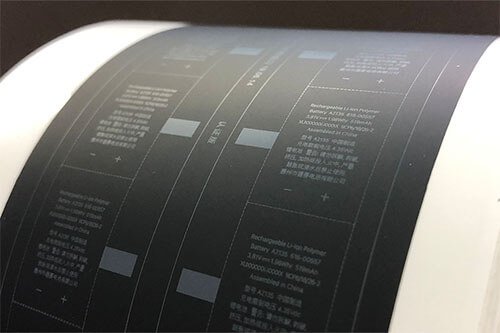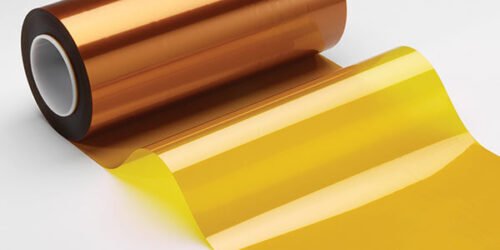Everything You Need to Know About Polyimide Label Material
2022/01/23

Polyimide label material (Kapton) is a high-temperature, heat-resistant polymer that is used in a wide variety of industries. This material has an excellent performance in all physical, chemical and electrical properties over a wide temperature range. In addition, it maintains good dimensional stability at high temperatures. In addition, polyimide labels can be printed using offset printing, flexographic printing, thermal transfer printing, or other methods. Polyimide label material can be used in a variety of industries including aerospace, electronics, automotive, and engineering.
What is polyimide label material and what are its benefits?
Polyimide is a heat-resistant, synthetic polymer that can withstand high temperatures. It’s often used in industrial settings where labels need to withstand extreme conditions. Polyimide labels are durable and long-lasting, making them ideal for applications where traditional paper or plastic labels would not survive.
Polyimide labels provide a number of benefits, including:
- Excellent heat resistance: they can withstand temperatures up to 300°C, making them perfect for use in high heat environments.
- Chemical resistant and UV resistant: They won’t fade or become damaged over time.
- Polyimide labels are very flexible: They can conform to curved surfaces or be applied to irregularly shaped objects.
- Polyimide is a flame retardant and fire-resistant material: It is often used as an insulator or heat shield in electronic components.
Polyimide labels are perfect for any industry that experiences high temperatures. The material is durable and will withstand harsh environments, making it ideal in the automotive or aerospace sectors. Polyimide labels are also flame retardant and fire resistant, making them an ideal choice for applications where safety is a concern, such as lithium battery label.

How does polyimide label material compare to other materials?
Polyimide is often compared to other label materials, such as paper or PVC. Here are some key points to consider when comparing polyimide with other materials:
- Polyimide is more durable than paper or PVC labels. It can withstand extreme temperatures and harsh environments.
- Polyimide labels are thinner and more flexible than other materials. This makes them ideal for applications where space is limited, such as on circuit boards or in medical devices.
- Polyimide labels have excellent resistance to abrasion and UV light. This makes them suitable for outdoor applications.
How to print on polyimide label?
There are several ways to print on polyimide labels. The most common method is offset printing, flexographic printing, letterpress printing, gravure printing, followed by thermal transfer printing, and screen printing. Choosing the right printing method will depend on the desired results.
The printing graphics and texts are fine and rich in layers, and the labels are printed from roll to roll, because of its fast production speed, volatile drying ink is required.
The quality is not inferior to offset printing. The advantage is that the equipment is simple, the cost is low, and the printing quality is comparable to offset printing and gravure printing. Flexographic printing uses offset inks and UV inks, both of which do not cause environmental pollution.
The quality of the flexographic printing is closely related to water-based ink or UV inks by changing their properties, you can adapt them for different substrates and get better results.
Gravure printing is the go-to form of label printing for commercials and other high-profile projects. The inks are fast drying, which helps with time constraints on this type printing; they also have a higher degree automation than other methods do–which means less human error.
This method uses heat to transfer ink from a ribbon onto the polyimide surface. The ribbon is first passed over a heating element, which melts the wax-based ink. The molten ink is then transferred to the polyimide surface, where it cools and hardens.
Thermal transfer printing is fast and reliable, and produces high-quality prints. However, it does have some limitations. The most significant limitation is that thermal transfer ribbons are relatively expensive. Additionally, thermal transfer printers require frequent calibration to ensure that the prints are of consistent quality.
Strong ink color, strong three-dimensional effect, low overprinting accuracy, not suitable for film label production.
To ensure that the print adheres well to the polyimide surface, it is important to use a material with the right dyne value. The dyne level should be ≧ 38 dynes/cm. If the dyne level is too low, the print will not adhere well to the surface.
Applications for polyimide labels in various industries
Polyimide labels are perfect for a variety of applications where durability, heat resistance and chemical resistance are key. Polyimide labels can be used in a variety of industries due to their diverse set of properties. Some of the most common applications for polyimide labels include:
- Electronics Industry: Polyimide labels are commonly used as electronic component markings and wire harness labeling in the electronics industry. They are also used in printed circuit board assembly and other applications where durability and heat resistance are required.
- Medical Industry: Polyimide labels are often used in the medical industry for labeling of surgical instruments, diagnostic equipment, and patient identification. They can withstand repeated sterilization cycles and maintain their legibility over time.
- Automotive Industry: The polyimide labels of the automotive industry provide a variety for applications, including engine and emission control labeling as well tire/wheel marking.
- Telecommunications Industry: Polyimide labels are used in the telecommunications industry for cable and wiring identification. The durability of the polyimide material means that they can withstand extreme temperatures and harsh environments, making them ideal for use in this industry.
Polyimide labels have a wide range of applications due to their unique properties. If you are in need of a durable and heat resistant label, polyimide may be the perfect material for your needs. contact us about this versatile material.
How to choose the right type of polyimide label for your needs?
Polyimide Labels are a great choice for many different types of labeling needs. When it comes down to choosing which one is right for you, there’s some things that will need taking into account before making your decision final.
The first is the label color. matte white and matte black are the most popular choices, but there are also clear and metallic options available.
The second is the adhesive. There are two types of adhesives used for polyimide labels: permanent and removable. Permanent adhesives are great for applications where the label will be exposed to high temperatures or harsh environments. Removable adhesives are perfect for applications where the label needs to be removed without damaging the surface beneath it. When choosing the right type of polyimide label, consider the color, adhesive, and application to ensure you get the perfect label for your needs.
Category

